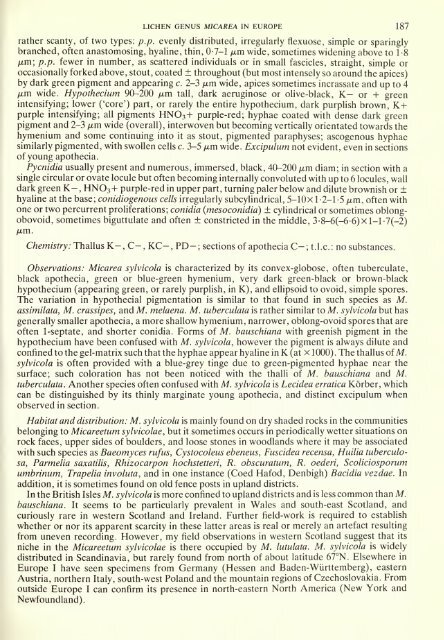Bulletin of the British Museum (Natural History)
Bulletin of the British Museum (Natural History)
Bulletin of the British Museum (Natural History)
You also want an ePaper? Increase the reach of your titles
YUMPU automatically turns print PDFs into web optimized ePapers that Google loves.
LICHEN GENUS MICAREA IN EUROPE 187<br />
ra<strong>the</strong>r scanty, <strong>of</strong> two types: p.p. evenly distributed, irregularly flexuose, simple or sparingly<br />
branched, <strong>of</strong>ten anastomosing, hyaline, thin, 0-7-1 /xm wide, sometimes widening above to 1-8<br />
fim; p.p. fewer in number, as scattered individuals or in small fascicles, straight, simple or<br />
occasionally forked above , stout, coated ± throughout (but most intensely so around <strong>the</strong> apices)<br />
by dark green pigment and appearing c. 2-3 /xm wide, apices sometimes incrassate and up to 4<br />
/Lim wide. Hypo<strong>the</strong>cium 90-200 /xm tall, dark aeruginose or olive-black, K- or + green<br />
intensifying; lower ('core') part, or rarely <strong>the</strong> entire hypo<strong>the</strong>cium, dark purplish brown, K-lpurple<br />
intensifying; all pigments HNO3+ purple-red; hyphae coated with dense dark green<br />
pigment and 2-3 /xm wide (overall), interwoven but becoming vertically orientated towards <strong>the</strong><br />
hymenium and some continuing into it as stout, pigmented paraphyses; ascogenous hyphae<br />
similarly pigmented, with swollen cells c. 3-5 /xm wide. Excipulum not evident, even in sections<br />
<strong>of</strong> young apo<strong>the</strong>cia.<br />
Pycnidia usually present and numerous, immersed, black, 40-200 /xm diam; in section with a<br />
single circular or ovate locule but <strong>of</strong>ten becoming internally convoluted with up to 6 locules, wall<br />
dark green K- , HNOs-f- purple-red in upper part, turning paler below and dilute brownish or ±<br />
hyaline at <strong>the</strong> base; conidiogenous cells irregularly subcylindrical, 5-10 x 1-2-1 -5 /xm, <strong>of</strong>ten with<br />
one or two percurrent proliferations; conidia (mesoconidia) ± cylindrical or sometimes oblongobovoid,<br />
sometimes biguttulate and <strong>of</strong>ten ± constricted in <strong>the</strong> middle, 3-8-6(-6-6)xl-l-7(-2)<br />
/xm.<br />
Chemistry: Thallus K-, C-, KC-, PD-; sections <strong>of</strong> apo<strong>the</strong>cia C-; t.l.c: no substances.<br />
Observations: Micarea sylvicola is characterized by its convex-globose, <strong>of</strong>ten tuberculate,<br />
black apo<strong>the</strong>cia, green or blue-green hymenium, very dark green-black or brown-black<br />
hypo<strong>the</strong>cium (appearing green, or rarely purplish, in K), and ellipsoid to ovoid, simple spores.<br />
The variation in hypo<strong>the</strong>cial pigmentation is similar to that found in such species as M.<br />
assimilata, M. crassipes, and M. melaena. M. tuberculata is ra<strong>the</strong>r similar to M. sylvicola but has<br />
generally smaller apo<strong>the</strong>cia, a more shallow hymenium, narrower, oblong-ovoid spores that are<br />
<strong>of</strong>ten 1-septate, and shorter conidia. Forms <strong>of</strong> M. bauschiana with greenish pigment in <strong>the</strong><br />
hypo<strong>the</strong>cium have been confused with M. sylvicola, however <strong>the</strong> pigment is always dilute and<br />
confined to <strong>the</strong> gel-matrix such that <strong>the</strong> hyphae appear hyaline in K (at x 1000) . The thallus <strong>of</strong> M.<br />
sylvicola is <strong>of</strong>ten provided with a blue-grey tinge due to green-pigmented hyphae near <strong>the</strong><br />
surface; such coloration has not been noticed with <strong>the</strong> thalli <strong>of</strong> M. bauschiana and M.<br />
tuberculata. Ano<strong>the</strong>r species <strong>of</strong>ten confused with M. sylvicola is Lecidea erratica Korber, which<br />
can be distinguished by its thinly marginate young apo<strong>the</strong>cia, and distinct excipulum when<br />
observed in section.<br />
Habitat and distribution: M. sylvicola is mainly found on dry shaded rocks in <strong>the</strong> communities<br />
belonging to Micareetum sylvicolae, but it sometimes occurs in periodically wetter situations on<br />
rock faces, upper sides <strong>of</strong> boulders, and loose stones in woodlands where it may be associated<br />
with such species as Baeomyces rufus, Cystocoleus ebeneus, Fuscidea recensa, Huilia tuberculosa,<br />
Parmelia saxatilis, Rhizocarpon hochstetteri, R. obscuratum, R. oederi, Scoliciosporum<br />
umbrinum, Trapelia involuta, and in one instance (Coed Hafod, Denbigh) Bacidia vezdae. In<br />
addition, it is sometimes found on old fence posts in upland districts.<br />
In <strong>the</strong> <strong>British</strong> Isles M. sylvicola is more confined to upland districts and is less common than M.<br />
bauschiana. It seems to be particularly prevalent in Wales and south-east Scotland, and<br />
curiously rare in western Scotland and Ireland. Fur<strong>the</strong>r field-work is required to establish<br />
whe<strong>the</strong>r or nor its apparent scarcity in <strong>the</strong>se latter areas is real or merely an artefact resulting<br />
from uneven recording. However, my field observations in western Scotland suggest that its<br />
niche in <strong>the</strong> Micareetum sylvicolae is <strong>the</strong>re occupied by M. lutulata. M. sylvicola is widely<br />
distributed in Scandinavia, but rarely found from north <strong>of</strong> about latitude 67°N. Elsewhere in<br />
Europe I have seen specimens from Germany (Hessen and Baden-Wiirttemberg), eastern<br />
Austria, nor<strong>the</strong>rn Italy, south-west Poland and <strong>the</strong> mountain regions <strong>of</strong> Czechoslovakia. From<br />
outside Europe I can confirm its presence in north-eastern North America (New York and<br />
Newfoundland).

















